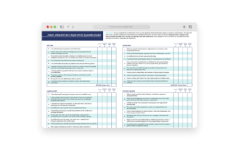Attachment patterns define how we connect with others in times of closeness and intimacy. However, they also show up most powerfully in moments of stress and disconnection, when our nervous system’s survival responses kick into high gear.
Understanding how different attachment styles respond to stress gives us crucial insights into our clients’ relationship patterns—and helps explain why some therapeutic approaches may work better than others during periods of heightened activation.
Consider a client whose typically mild anxiety escalates during a relationship conflict, or another who usually engages well in therapy but becomes distant and defensive when discussing childhood experiences. These shifts aren’t random—they’re windows into how early attachment experiences shaped their threat response systems.
For clinicians, recognizing these patterns offers more than just theoretical insight. It provides practical guidance for how to approach our most challenging therapeutic moments: when to lean in with support, when to respect distancing, and how to maintain therapeutic presence even as our clients’ attachment patterns activate in the room.
Share this Article:
Top Picks for You:
- The Four Attachment Styles: Secure, Avoidant, Ambivalent, and Disorganized
- Toxic Shame: What Is It & What to Do About It
- The Power of Trauma-Informed Care: Understanding What Happened to You
- Somatic Resilience: Overcoming Early Trauma (with Peter A. Levine, PhD)
- Neuroplasticity: Rewiring the Traumatized Brain
Attachment Under Stress: A Guide to Activated Attachment Patterns
Stress and Attachment
Every threat response begins with the activation of our autonomic nervous system. As humans, we’re wired for both physical and social survival, which means that when we perceive a threat, we instinctively evaluate not just our physical safety, but our social resources and relationships as well.
This is where attachment patterns come into play. Our earliest relationships create the template for how we connect with others and manage distress.
These attachment adaptations typically fall into one of four distinct styles—secure, anxious-preoccupied, avoidant-dismissive, and disorganized-fearful. When our nervous system activates, whether the threat is physical, emotional, or relational, our attachment adaptations come online to protect us.

When Connection Becomes Overwhelming
For those with avoidant attachment patterns, stress often triggers an instinct to withdraw and self-regulate. Early experiences of neglect or a lack of emotional soothing lead these individuals to deactivate their attachment needs and rely on themselves.
From the outside, this can look like emotional shutdown, and relational partners may describe these individuals as “cold” or “detached.” In these moments, it’s important to remember that this response is a protective strategy, aimed at managing overwhelm through independence and self-reliance.
During periods of heightened stress, these clients may:
- Pull back from therapeutic engagement, often preferring to “handle things on their own”
- Focus intensely on practical problem-solving while dismissing emotional content
- Minimize their need for connection or support from others
- Strengthen boundaries around vulnerability, or attempt to diminish their experiences of struggle
- Reduce their emotional expression, especially around difficult feelings
Yet this pattern carries important adaptive wisdom. The capacity to step back, self-regulate, and maintain clear boundaries under pressure is a valuable skill. These clients often show remarkable resilience in handling practical challenges independently.
However, disconnection from others can often lead to disconnection from self, through dissociation or emotional numbing. Where avoidantly attached clients often need support is in discovering that connection can be safe and regulated. The goal isn’t to eliminate their capacity for independence but to expand their range of responses to include the possibility of reaching out when needed.
In therapeutic settings, this means working with—rather than against—their need for emotional space. Support might look like:
- Respecting their need to process internally while maintaining a steady, non-demanding presence
- Offering concrete self-regulation tools that can ease the transition from shutdown or isolation into social engagement
- Acknowledging their independence while helping them recognize and express their needs for connection
- Collaborating on finding a comfortable pace for emotional engagement
- Normalizing their need for space while helping them recognize early signs of isolation
The key is remembering that avoidant attachment isn’t a therapeutic resistance to overcome, but an adaptive response that once provided safety. By honoring these patterns while gently expanding possibilities, we create the conditions for clients to discover new ways of navigating their relationships with others and with themselves.
When Disconnection Feels Dangerous
For clients with anxious attachment patterns, stress activates an intense drive for connection and reassurance. Inconsistent emotional availability from caregivers taught these individuals to amplify their attachment needs as a way to maintain critical relationships.
This can lead to “clingy” or “demanding” behaviors in adulthood, and partners often report feeling overwhelmed by the intensity of their emotional needs. Yet beneath these behaviors lies a protective strategy: the belief that survival depends on maintaining connection at all costs.
During periods of heightened stress, these clients may:
- Intensify their help-seeking behaviors, often urgently reaching out to multiple sources of support
- Experience overwhelming emotional flooding and difficulty self-regulating
- Struggle to maintain boundaries, fearing that any distance signals abandonment
- Demonstrate heightened sensitivity to perceived rejection or withdrawal
- Focus intensely on relationship dynamics while losing sight of other aspects of life
These patterns are just another adaptation to less-than-ideal situations in childhood. Unlike avoidants, anxiously attached individuals are often adept at recognizing their emotional needs and readily reach out for support. These clients often show remarkable attunement to relationships, a deep capacity for empathy, and are in touch with their desire for emotional intimacy.
However, this heightened sensitivity to relationships can become overwhelming without adequate self-regulation skills. Where anxiously attached clients often need support is in developing a sense of internal security and learning to navigate relationships with less emotional dysregulation.
In therapy, this might look like:
- Supporting the development of self-regulation skills while validating their need for connection
- Helping them recognize and trust their own internal resources
- Creating clear, consistent boundaries in the therapeutic relationship as a model for other relationships
- Teaching distress tolerance skills for managing attachment anxiety
- Exploring ways to maintain connection while respecting others’ needs for space
By helping anxiously-attached clients build a foundation of internal security while honoring their deep capacity for connection, we create opportunities for them to experience relationships in a new way—one where reaching out becomes a choice rather than a survival response.

When Stress Brings Confusion
When working with disorganized attachment patterns, stress can elicit seemingly contradictory responses—sometimes simultaneously. Unlike the more organized patterns we’ve discussed, these individuals might swing between intense seeking and fierce withdrawal, or freeze entirely when their attachment system activates. This unpredictability makes sense when we understand that their early experiences often involved caregivers who were both the source of safety and the source of threat.
This complexity shows up in therapy in unique ways. A client might desperately seek connection one moment, then abruptly shut down or become hostile the next. They might describe feeling both intensely afraid of abandonment and equally terrified of closeness. This inconsistency reflects an early environment where no single strategy could ensure safety.
This flexibility of response also highlights these individual’s ability to find creative solutions to complex relationships and to maintain vigilance when it’s genuinely needed.
When supporting these clients, therapeutic attention should focus on:
- Maintaining consistent, predictable responses even when clients shift between different attachment strategies
- Creating a therapeutic environment where all parts of their experience are welcome and processed
- Helping clients recognize and track their shifting attachment responses without judgment
- Building tolerance for both connection and autonomy in small, manageable steps
- Supporting integration of different emotional states while respecting the protective nature of disconnection
- Paying careful attention to pacing, and the client’s window of tolerance
Working with disorganized attachment patterns requires a delicate balance of honoring survival adaptations while creating space for new possibilities. By providing consistent, predictable responses and respecting the wisdom in these seemingly contradictory patterns, we can help clients gradually develop more integrated ways of navigating relationships—always moving at a pace that feels manageable and safe.
When Security Gets Tested
Thanks to responsive caregivers and experiences of protection, presence, and autonomy, securely attached individuals tend to have flexible and regulated stress responses. They can generally maintain access to both self-soothing and support-seeking strategies, allowing them to respond appropriately to challenges.
It’s important to note, however, that secure attachment can be either innate (that is, developed in childhood) or earned, through relational growth and therapeutic work later in life. Those with earned security might experience more activation during stress, or even revert to their early patterning. However, through intentional work, people can learn to:
- Notice when they’re getting activated
- Choose their responses rather than reacting automatically
- Return to regulation more quickly
- Learn from challenging experiences
When secure attachment skills like these are readily available, stress responses might look like:
- Recognizing and naming emotional needs without shame or hesitation
- Flexibly moving between self-reliance and support-seeking as needed
- Maintaining boundaries while staying connected to others
- Communicating directly about needs and concerns
- Staying present with difficult emotions without becoming overwhelmed
- Trusting in the availability of support while respecting others’ limitations
This capacity for this flexible response to stress isn’t a destination but an ongoing journey. It’s a blueprint we can all return to, through conscious work and supportive relationships.
Understanding how different attachment patterns respond to stress helps us create more effective therapeutic environments—ones that honor our clients’ adaptive strategies while supporting their growth toward more flexible responses. Whether working with avoidant withdrawal, anxious activation, disorganized responses, or earned security, our role remains consistent: to provide the safety, attunement, and regulation that allows new possibilities to emerge





Ready to Begin Your Healing Journey?
Browse on-demand courses and begin learning from top experts today!


